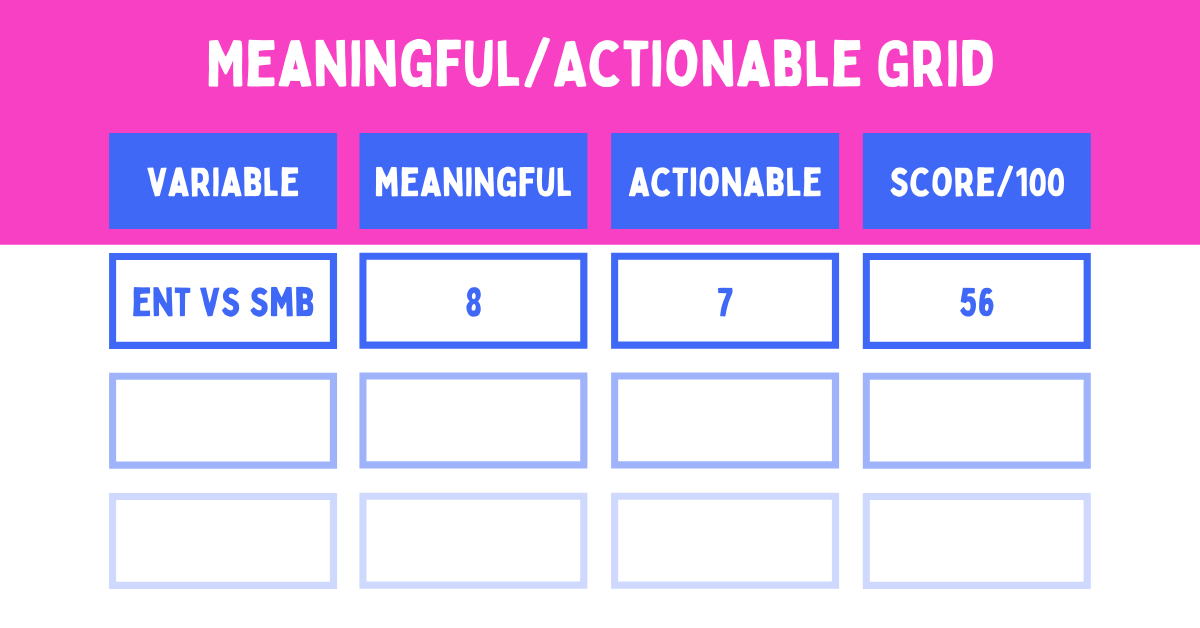Market segmentation? Unwrap the best way to nail your marketing strategy

If I get market segmentation wrong, I'm screwed.
Not entirely, but after years of having personas and ideal customer profiles hammered into my skull, learning more about proper market segmentation is a breath of fresh air.
If the market I target doesn't exist or is too loosely defined, I'm screwed. How's that for a breath of fresh air?
Learning how to segment a market - and I mean the entire market - gives me clarity on exactly who is in the market and where to find them. Market segmentation is the step before building personas because it tells me if there's enough of a market there to make it worthwhile. I can write a 100% accurate persona, but if that persona is in a teeny tiny segment there ain't much of a market to fight over.
What is market segmentation?
Market segmentation splits a total addressable market into smaller sets of customers who share similar identifiable characteristics, the most important of which are needs based.
There are two main benefits of market segmentation:
- Companies can make and sell products that more closely fit the needs and wants of a segment
- Marketing gets a whole lot easier and way more efficient when I know who we make our products for
A proper market segmentation includes the whole market. Not just the people I think I want to target. Nope! Good market segmentation results in a clear understanding of who is in a market and how I can meaningfully grouped people or businesses together with as little overlap as possible.
This is not segmenting "our customers" or reviewing "our data." Market segmentation is about the market, not you and not me. Not our business. Not our products. A good segmentation is purely market-focused in the same way a good persona is all about who our customer is and how they behave.
Proper market segmentation blends:
- Consumer behavior (what they do and buy)
- Psychographics (beliefs and attitudes)
- Demographics/Firmographics (external characteristics)
- Inter-segment influence that flows between groups in a market (whose opinions and behaviors effect others')
What market segmentation is not
Market segmentation is not about marketing or sales or product development. The focus is entirely on the market and determining who the customers are and how they can be grouped together.
Market segmentation is not about targeting, positioning, or sales motions. Those come later.
Segmentation is not stereotyping. No, stereotypes are not market segments. Stereotypes are usually broad generalizations of people who may have one thing in common, but who are different in their wants, needs and interests. Stereotypes are for lazy, bullshit marketers.
"Millenials" is a bullshit market segment. Just like "Boomers" and "College kids." Yes, we can lump these groups together based on when they were born, but they are each wildly diverse groups that never think and act like a bloc. Yeah, "Millenials" are consumers. No, they're not an identical blob of young people and they are not a segment.
Market segmentation is step 1 of 3 for marketing success
If my company is market oriented link to previous article and we've done our market research link to older article, there is a three-step process to follow for marketing success:
- Segment the whole market
- Target the segments that best fit our goals
- Position our brand, product, company in their minds
Market segments should be measurable, substantial, accessible, differentiated, and actionable
I need to know - or be able to learn - how large a segment is and whether or not it's big enough that we can make money from it. I need to know if I can cost-effectively reach the people in a segment.
Each segment should be clearly differentiated. Meaning there is little overlap in beliefs, attitudes, characteristics, and behaviors of the people in each segment. And when I can find a segment that ticks all the boxes, I have to ask if I can connect with them and sell them what they need.
How to show segmentation work

The Meaningful/Actionable Grid (h/t Mark Ritson) is the culmination of my segmentation work. The Grid lays out my total market in an easy-to-understand table where, once complete, I can see what each segment looks like and how they influence one another.
The Grid makes it simpler to decide which segment(s) I'll target.
Here's how to create one:
Want an easy-to-use spreadsheet to build your list of variables? Click here to get a free spreadsheet and work along with the instructions below.
- List all the variables I might use to slice or segment the marketplace. The longer the list, the better. Write everything down. This is a good team exercise.
- Rate each of these variables from 1-10 on how much impact it has on a consumer's behavior. Anything that does not have meaningful impact on behavior is 1. A variable that has a direct impact on behavior is a 10.
- On a scale of 1-10, score each variable on how available and actionable the data is. Ask do I have this data? and can I identify actual customers according to this variable? 1 means the data is impossible to get. 10 means the data is easily accessible and I might already have it.
- Multiply the Meaningful scores by the Actionable scores for a variable score out of 100.
- Rank the variables in order of score from largest to smallest. This is my list of variables that are both meaningful (have an impact on consumer decisions to buy) and actionable (the data is accessible). Choose the top 4-6 variables before moving on.
- Starting from the highest scoring variable, create a grid to start comparing the variables. The simplest way to start is to include two columns, one for non-customers and one for customers. Using the high-scoring variables, I build my segment map by adding rows and dividing the columns into groups.
- With the variables broken into segments I can start to look - using my research - for behavioral similarities. Where there is overlap between groups of people who may not be the same demographically (represented by boxes on this grid) but who behave in similar ways, combine the cells to create a bigger segment.
- Give each segment a name that describes the behavior. Don't get cute here. If we're talking about middle managers who browse our content, a name like Mid-level Browser gives a clear impression of who these people are. A name like Occasional Ollie does not.
- Add the population size of each segment. I can get this number by extrapolating the percentage of people in this group in our research out to the entire population of the market.
- Value each segment by multiplying the average value of each person times the total population of the segment.
- Add our market share, or how much of the market we currently own. This number should come out of our research, too.
- Identify and indicate any spillover or influence that one segment has over another. These are segment dynamics that can help our strategy later.
At the end of this exercise, we should have a Grid that looks like the one above. We have clear market segments, each with a name that our sales team could easily recognize and understand. We can see how each segment influences or is influenced by another. We're ready to choose our target segments.
How do we know if our segmentation is any good?
It is possible to assess our segmentation before applying it to everything we do. Here is Mark Ritson's advice for assessing good segmentation:
- Have we included the whole potential market? The answer must be yes. If not, keep working until we have mapped the entire market.
- Can any customer belong to more than one segment? If yes, revisit the segments to make them exclusive.
- Is each segment homogenous inside and heterogenous to other segments? Everyone in a segment should be similar to each other and look different from people or organizations outside the segment.
- Are the names based on customer behavior? A good test is to ask colleagues what they think a name means. If they guess it, we're onto a good thing. If they don't understand it quickly, find a more accurate name and test again.
- Does the total number of customers identified on our Grid equal the total market size? When we add up current total segment value (Segment Value x Our Market Share) does it equal our actual revenue? If not, find and add in the rest. We want to see our whole market so we can make educated targeting choices later.
- Are segment dynamics included and can we map how different segments influence one another? Which segments influence the others? Does buying behavior in one group lead to buying in another? Make a note of these influencers.
- Can we identify real customers for each segment? We should be able to identify real customers who fit into each segment. If we share our segment names with our teammates, can our they quickly identify real customers who fit these segments?
What does your market look like?
Market segmentation is a bigger job than I thought. I used to believe that developing a series of buyer personas was enough market research to help kickstart growth, but personas are one piece of understanding our market. By skipping segmentation and only developing personas, we lack visibility over how large or small our total market is and who we should target. Just because a particular persona makes up the bulk of our current customer base does not mean it's the best one to target.
So, what does your market look like? Remember, you can get a copy of the segmentation spreadsheet here.
This is the first post in a series on marketing. Here's a full list of the other posts. I'll update each one with links as soon as they're published.
- How epic companies like Nike and Amazon grab advantage with market orientation
- How to do market research for a startup (from a Saas product marketer)
- Your next market targeting strategy must highlight these two things
- What is market positioning and where does it fit into your marketing strategy?
- Objectives (coming)
- Product (coming)
- Pricing (coming)
- Integrated Marketing Communications (coming)
- Distribution (coming)



